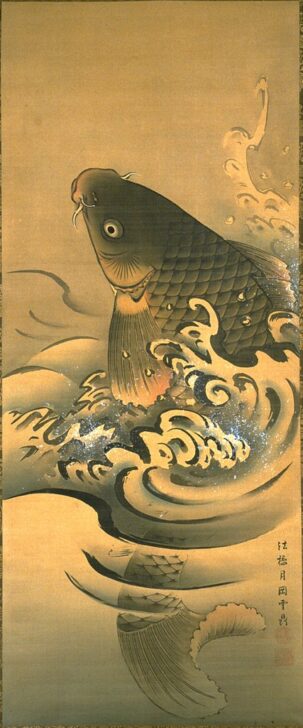Leaping Carp
Tsukioka Settei

Description
Tsukioka Settei
Japan, ca. 1726–1786
Leaping Carp
Edo period (1615–1868)
18th century
Hanging scroll, ink and color on silk
Gift from the Estate of Frances Eileen Lay, 1987/2.16
Tsukioka Settei was a prolific painter and book illustrator active in
the area around Osaka, the center of commercial activities in Edo-
period Japan. The leaping carp in this picture has a special meaning
in Japanese culture: Since only the strongest carp can leap over
small waterfalls to spawn, it was adopted as a symbol for healthy and
successful boys. Here, the fish’s robust body is a visual metaphor
for a well-developed boy. Carp flags are often displayed on what was
originally called Boy’s Day (May 5), but is now known as Children’s
Day—an occasion to celebrate childhood happiness and express
gratitude toward parents.
Summer 2023 Gallery Rotation
__________
Japan, 1710–1787
Leaping Carp
Edo period (1615–1868)
18 th century
Hanging scroll, ink and color on silk
Gift from the Estate of Frances Eileen Lay, 1987/2.16
Tsukioka Settei was a prolific painter and book illustrator active in the area
around Osaka, the center of commercial activities in Edo-period Japan. The
leaping carp in this picture has a special meaning in Japanese culture: Since only
the strongest carp can leap over small waterfalls to spawn, it was adopted as a
symbol for healthy and successful boys. The robust body of the fish in the scroll
is thus a visual metaphor for a well-developed boy. The carp is often displayed in
the form of flags on what was originally called Boy’s Day (May 5; now Children’s
Day)—an occasion to celebrate children’s happiness and express gratitude
towards parents.
Subject Matter:
The leaping carp in this picture has a special meaning in Japan. Since only the strong carp can leap over small waterfalls to spawn, it was adopted as a symbol for healthy and successful boys. The robust body of the fish in the scroll is therefore a visual metaphor, equivalent to the depiction of a well-developed boy.
Physical Description:
There is a carp leaping out of a body of water. The front half of its body if in the air while the bottom half is still submerged in water. Ripples and mini waves are shown where the carp is emerging from the water. The water and sky have a reddish hue to it, there are a couple splashes of blue where the waves are. In the bottom right corner of the painting, there is a signature and two seals of the artist.
Usage Rights:
If you are interested in using an image for a publication, please visit https://umma.umich.edu/request-image/ for more information and to fill out the online Image Rights and Reproductions Request Form.